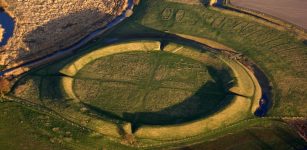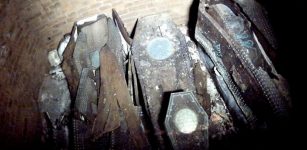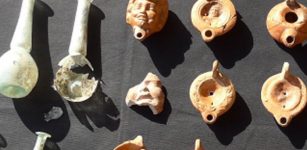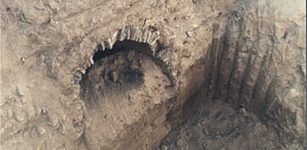Viking Sword Unearthed In Grave Excavated by Archaeologists In Central Norway
Conny Waters – MessageToEagle.com – During the Viking Age—probably sometime in the 800s-900s—a man died in the village we call Vinjeøra today, south of Trøndelag county. He was buried with a full set of weapons: ax, spear, shield and sword.
Some 1,100 years later, archeologist Astrid Kviseth bends over his grave and painstakingly cleans his sword. Soon she will pick it up from the ground and become the first person to hold it in her hands since Viking times.

Swords are usually placed on the right side of the body in weapon graves like this. In this grave, it was laid on the warrior’s left side. One explanation may be that the warrior was left-handed. Credit: Ellen Grav Ellingsen, NTNU University Museum
We’ll come back to that in a moment.
First we need to talk more about the man who once owned this sword.
“The fact that he was buried with a full set of weapons tells us that this was a warrior, and in Viking times and the early Middle Ages, most warriors were free men who owned their own farms,” says Raymond Sauvage, an archeologist at the NTNU University Museum and project manager for the excavation.
The weapon grave was found during the excavation of a farm and burial ground from Viking times, which archeologists are investigating in connection with the expansion of European route E39 route through Vinjeøra.
“The law in the Middle Ages dictated that a farmer had to procure weaponry. First you were required to get an ax and a shield, and eventually you could also have a spear and a sword,” says Sauvage.
Left-handed warrior?
“What makes this grave a little special is that the sword is on what we assume was the deceased’s left side,” Sauvage says.
The sword was normally placed on the right side of the body in weapon graves like this. This custom is actually a little strange, because as a warrior you want to fasten your sword on your left side to be able to pull it out with your right hand.
“Why the swords are almost always placed on the right side is a bit mysterious. One theory is that the underworlds you go to after death are the mirror image of the upper world,” says Sauvage.
But what does it mean when the sword is on the left side—which you would initially think was the logical side?

In the same area, archaeologists discovered what they believe was a woman’s grave, based on the artefacts they found – like this bead. Credit: Raymond Sauvage, NTNU University Museum
“Maybe he was left-handed, and they took that into account for the afterlife? It’s hard to say,” says Sauvage.
Buried in a ditch
The (possibly) southpaw warrior’s grave partially overlapped the graves of three other warriors, who were laid to rest in the ditch surrounding one of the large burial mounds on the site. It may not sound like much of an honor to be buried in a ditch, but it probably was.
“We’ve seen lots of examples of reused graves on this burial ground. People were buried in the same grave or partly inside older graves. It was obviously important to lie next to or in the burial mounds and the ring ditches around them,” Sauvage says.
He adds that we do not know the reason why the graves overlap each other in this way, but believes some symbolism is clearly associated with the practice.
“We can imagine that this burial practice is an expression of how important the family’s ancestors were on a farm in Viking times. In addition to being present on the farm as companion spirits—fylgjur—the ancestors could continue to live physically in the burial mounds,” Sauvage says.
“So it was really important to have the ancestors in the burial ground on the farm,” he says. “This confirmed the family’s ownership of the land, and being buried close to an important ancestor or forefather (or -mother) was perhaps also a way to be included in the community of ancestral spirits.
Bones with magical powers
In the same ring ditch, archeologists also discovered a fourth grave that surprised them. The deceased was probably a woman, who was cremated in early Viking times or a little earlier.
The archeologists guessed the person’s gender based on the burial gifts, which included an oval brooch, a pair of scissors and beads. What makes this grave special, however, is the large amount of bones—probably at least a couple of kilos worth.
“A study done several years ago showed that cremation graves from the Iron Age on average contain only about 250 grams of bone. A dead human body that is cremated, on the other hand, burns down to about 2 kilos of bones,” Sauvage says.
The woman in this grave was apparently buried in her entirety, although archeologists could also identify some bird bones in the material. But why are so few bones usually found in cremation graves—and what happened to the rest?
“We know very little about that. From saga sources we know that the bones of the ancestors were ascribed magical properties, such as giving strength and curing disease. So we can imagine that the bones might have been actively used in some kind of ritual,” says Sauvage.
Surprisingly heavy
The awe in the air is palpable when the sword begins to release its grip on the ground and archeologist Astrid Kviseth prepares to lift it out. Taking a Viking sword out of the ground is no everyday event, so a little bit of nerves is to be expected. You don’t want to be the one who after a thousand years drops the sword so it breaks.
Fortunately, the sword is solid, and with a sure hand Astrid lifts it into a padded box.
“I’m a little surprised at how heavy it was. I don’t exactly know how heavy a sword is, but it had some heft to it. You would have had to be pretty strong to be able to swing this sword!” says Kviseth.
As all the field archeologists take turns lifting the sword box to predict how many milk cartons the sword weighs, Sauvage looks forward to learning more about what is hidden underneath all the rust.
“It will be exciting to get the sword into the conservation laboratory and have it x-rayed so we can see what’s hiding under the corrosion. Maybe it has ornamentation or pattern welding in the blade,” he says.
via Physorg
Written by Conny Waters – MessageToEagle.com – AncientPages.com Staff Writer










